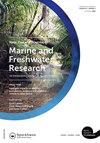分配、配额和鲍鱼渔业管理:重新审视公地悲剧
IF 1.7
4区 环境科学与生态学
Q3 FISHERIES
New Zealand Journal of Marine and Freshwater Research
Pub Date : 2023-10-26
DOI:10.1080/00288330.2023.2273468
引用次数: 1
摘要
渔业管理使用各种方法来评估种群,分配配额或分配,并计算可持续性潜力。在新西兰鲍鱼(pāua)渔业中,任何捕捞年度的总存量和捕捞量都不为人所知,因为大部分是“娱乐性”捕捞,不需要许可证或捕捞报告。相对于分配的实际收获要到捕捞季节过后才能确定,而且需要通常不收集的数据。在受地震影响的南岛东北海岸,经过5年的休渔期后,3个月的捕鱼季重新开始,证明了这一点。休闲渔民对虹膜盘藻种群的近岸生物量减少了0.74%。这实际上是一场“公地悲剧”,即公共资源被最先收获的人剥削,而很少考虑剩下的资源。潜在的弱点是休闲捕鱼管理规则,在这种情况下,为鲍鱼种群在全球范围内面临压力提供了鲜明的教训。我们讨论了概念、先验知识、管理惯性和潜在的前进方向,目的是防止pāua人口的连续枯竭,促进更有效的管理,结束公地悲剧。本文章由计算机程序翻译,如有差异,请以英文原文为准。
Allocations, quota and abalone fishery management: the Tragedy of the commons revisited
Fisheries management uses a variety of methods to assess stocks, assign quota or allocations, and calculate potential for sustainability. In the New Zealand abalone (pāua) fishery, neither the total stocks nor amount removed in any fishing year are well-known because a major portion is fished ‘recreationally’, for which there is no requirement for a licence or catch reporting. Actual harvests relative to allocations cannot be established until well after the fishing season, and require data not typically collected. This was demonstrated over a 3-month fishing season opened after a 5-year closure along the earthquake-affected northeastern coast of the South Island. Recreational fishers removed c.74% of nearshore biomass of Haliotis iris populations. This was, in effect, a Tragedy of the Commons, whereby a common resource is exploited by those who harvest first, with scant regard for what remains. The underlying weakness is in the recreational fishing management rules which, in this instance, provide stark lessons in why abalone populations have come under pressure worldwide. We discuss concepts, prior knowledge, inertia in management, and a potential way forward, with the aim of preventing serial depletion of pāua populations and fostering more effective management that ends the Tragedy of the Commons.
求助全文
通过发布文献求助,成功后即可免费获取论文全文。
去求助
来源期刊
CiteScore
4.50
自引率
12.50%
发文量
35
审稿时长
3 months
期刊介绍:
Aims: The diversity of aquatic environments in the southern continents and oceans is of worldwide interest to researchers and resource managers in research institutions, museums, and other centres. The New Zealand Journal of Marine and Freshwater Research plays an important role in disseminating information on observational, experimental, theoretical and numerical research on the marine, estuarine and freshwater environments of the region.

 求助内容:
求助内容: 应助结果提醒方式:
应助结果提醒方式:


